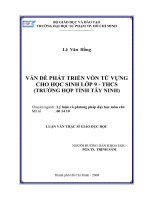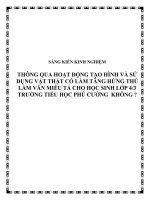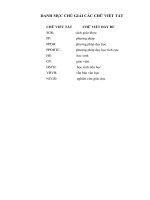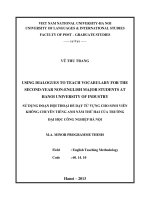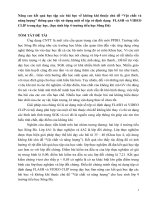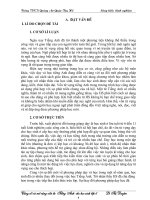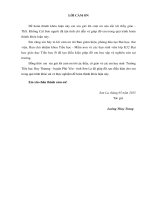Sử dụng kể chuyện nhằm tăng vốn từ vựng cho học sinh lớp 4 trường tiểu học quyết thắng
Bạn đang xem bản rút gọn của tài liệu. Xem và tải ngay bản đầy đủ của tài liệu tại đây (2.21 MB, 97 trang )
THAI NGUYEN UNIVERSITY
SCHOOL OF FOREIGN LANGUAGES
TRAN THI KIM LIEN
USING STORYTELLING TO IMPROVE VOCABULARY FOR THE
PUPILS OF GRADE 4 AT QUYET THANG PRIMARY SCHOOL
(Sử dụng kể chuyện nhằm tăng vốn từ vựng cho học sinh lớp 4
Trường Tiểu học Quyết Thắng)
MASTER THESIS RESEARCH
Field: English Linguistics
Code: 8220201
THAI NGUYEN - 2018
THAI NGUYEN UNIVERSITY
SCHOOL OF FOREIGN LANGUAGES
TRAN THI KIM LIEN
USING STORYTELLING TO IMPROVE VOCABULARY FOR THE
PUPILS OF GRADE 4 AT QUYET THANG PRIMARY SCHOOL
(Sử dụng kể chuyện nhằm tăng vốn từ vựng cho học sinh lớp 4
Trường Tiểu học Quyết Thắng)
MASTER THESIS RESEARCH
(APPLICATION ORIENTATION)
Field: English Linguistics
Code: 8220201
Supervisor: Dr. Bui Thi Huong Giang
THAI NGUYEN - 2018
DECLARATION
The writer fully declares that this research paper is composed by the writer herself,
and it does not contain materials written or having been published by other people,
and that from other references.
A THESIS
USING STORYTELLING TO IMPROVE VOCABULARY FOR THE
PUPILS OF GRADE 4 AT QUYET THANG PRIMARY SCHOOL
Submited by: Tran
Thi Kim Lien
Approved by
Supervisor,
Dr. Bui Thi Huong Giang
i
ACKNOWLEDGEMENTS
The thesis on “Using Storytelling to Improve Vocabulary for the Pupils of Grade 4
at Quyet Thang Primary School” came to completion. On this occasion, the writer
would like to thank all those people who have contributed to the completion of this
research report.
The deepest gratitude and appreciation are extended to Dr. Bui Thi Huong Giang,
the supervisor who has given her continuous guidance, helpful correction, moral
support, advice and suggestion, without her valuable support it is doubtful that this
thesis came into completion.
The writer’s deepest thank also goes to the following:
1. Mrs. Tran Thi Sau as the principal of Quyet Thang Primary School, who
has permitted and given the opportunity to the writer to carry out her study at the
school.
2. Mrs. Dinh Thi Lien as a teacher of English at Luong Ngoc Quyen Primary
School in Thai Nguyen City, Ms. Vu Thi Ngoc Anh as a teacher of English at Quyet
Thang Primary School, who have willingly shared their time to conduct the
treatment and collect some data needed for completing her study.
3. The teachers and students at Quyet Thang Primary School, especially
students in Class 4A and 4D at the academic year 2017-2018 who have participated
in this study.
4. All of the lecturers of The English Department of School of Foreign
Languages, Thai Nguyen University, who have guided and shared their knowledge
during her academic years.
5. Mrs. Nguyen Thi Xuan as a teacher of English at Thai Nguyen High School
for the Gifted, for her support, critic and guidance.
6. Her beloved parents and her younger brother and her best friends Ha and
Xuyen for their endless love, support and encouragement.
ii
The writer realizes that this thesis is still far from perfect. She therefore will be
glad to receive any constructive criticism and recommendation to make this thesis
better.
Finally, the writer expects that this thesis will be useful to the reader who
wishes to learn something about teaching methods, especially using Storytelling in
teaching English.
Thai Nguyen, October 2018
3
ABSTRACT
This study aims at improving primary pupils’ vocabulary by using storytelling
and find out the impact of using storytelling on young learners’ learning English
vocabulary. It also describes students’ perception and feeling after experiencing
Storytelling method. This research is action research which was conducted in Quyet
Thang Primary School in Thai Nguyen City in the second term of the academic year
2017-2018. It consists of planning, implementing the action, observing and
reflecting. The data were gained through tests, observation sheet, questionnaires and
interviews. The data attained from those instruments were analyzed using formula
to calculate mean, target of study, questionnaire percentage. The data then were
interpreted descriptively. The result of study shows that storytelling can improve
young learners’ English vocabulary during teaching and learning process. In
addition, it also improves students’ marks in the learning process. Furthermore,
according to students, this teaching method is considered as a fun, good, stress-less
method that helps them to memorize English words easily and makes their learning
easier.
Key words: storytelling, vocabulary, young learners
4
TABLE OF CONTENTS
DECLARATION ........................................................................................................ i
ABSTRACT .............................................................................................................. iv
TABLE OF CONTENTS ............................................................................................v
LIST OF TABLES ................................................................................................... vii
LIST OF CHART.................................................................................................... viii
LIST OF DIAGRAMS .............................................................................................. ix
CHAPTER 1. INTRODUCTION ...............................................................................1
1.1. Background of the study ..................................................................................1
1.2.Objectives of the study......................................................................................3
1.3. Research Questions ..........................................................................................3
1.4. The scope of the study......................................................................................3
1.5. Organization of the study .................................................................................4
CHAPTER 2. LITERATURE REVIEW ....................................................................6
2.1. Theoretical Framework ....................................................................................6
2.1.1. Teaching and learning a foreign language in elementary schools ............6
2.1.2. Characteristics of Young Learners............................................................7
2.1.3. The importance of vocabulary in teaching and learning foreign
languages .............................................................................................................
8
2.1.4. Storytelling in the classroom...................................................................10
2.1.4. Storytelling in teaching vocabulary ........................................................11
2.1.5. The Steps to Implement Storytelling ......................................................12
2.2. Previous studies on the use of storytelling to improve vocabulary for young
learners ..................................................................................................................14
CHAPTER 3. RESEARCH METHODOLOGY ......................................................20
3.1. Research Questions ........................................................................................20
3.2. The study design ............................................................................................20
3.3. Participants .....................................................................................................21
3.4. Materials.........................................................................................................21
5
3.5. Teaching Procedure........................................................................................22
3.6. Research Procedure ........................................................................................23
3.7. Data collection instruments ............................................................................26
3.8. Data analysis ..................................................................................................27
3.9. Indicators of Success ......................................................................................29
CHAPTER 4. FINDINGS AND DISCUSSION......................................................31
4.1 FINDINGS ......................................................................................................31
4.1.1 Observing .....................................................................................................31
4.1.2. The Questionnaire Findings ....................................................................36
4.1.3. The Semi-structured Interview Findings.................................................42
4.2. Discussion ......................................................................................................42
4.2.1. Students’ Activities .................................................................................42
4.2.2. Students’ Grade .......................................................................................43
4.2.3. Discussion of the Result of the Questionnaire and Interview. ................44
CHAPTER 5. CONCLUSION AND SUGGESTION ..............................................47
5.1. Conclusion......................................................................................................47
5.2. Suggestions ....................................................................................................48
REFERENCES..........................................................................................................51
APPENDIX 1 .............................................................................................................. I
APPENDIX 2 ........................................................................................................... IX
APPENDIX 3 ........................................................................................................... XI
APPENDIX 4 .......................................................................................................... XV
APPENDIX 5 ........................................................................................................ XVI
APPENDIX 6 ....................................................................................................... XVII
APPENDIX 7 ...................................................................................................... XVIII
APPENDIX 8 ........................................................................................................ XIX
APPENDIX 9 ......................................................................................................XXVI
6
LIST OF TABLES
Table 4.1 Pupils’ activities in the teaching-learning process....................................31
Table 4.2 Students’ grade achievement in the pre-test ..............................................33
Table 4.3 Students’ grade achievement in the post-test ............................................35
Table 4.4 Pupils’ perception and pupil’s feelings of personal enjoyment after
experiencing Storytelling method .............................................................................37
vii
LIST OF CHART
Chart 4.1 Pupils’ activities in the teaching-learning process ...................................32
8
LIST OF DIAGRAMS
Graphic 4.1 The target of the study in the pre-test....................................................34
Graphic 4.2 The target of the study in the post-test ..................................................35
Graphic 4.3 Storytelling is fun ..................................................................................38
Graphic 4.4 Storytelling as a useful method .............................................................39
Graphic 4.5 Storytelling as a teaching method .........................................................39
Graphic 4.6 Storytelling makes happy ......................................................................40
Graphic 4.7 Storytelling gives benefits .....................................................................41
Graphic 4.8 Storytelling gives pressure ....................................................................41
9
CHAPTER 1
INTRODUCTION
This chapter presents the introduction of the study. It is divided into five parts:
the background of the study, the objectives of the study, the scope of the study, the
research questions, the significance of the study and organization of the study.
1.1. Background of the study
Language plays a very important role in social relations among human beings.
It is a medium of communication which enables people to interact, converse, and
also to share with others. The most important language in the world is English
because it is considered the primary international communication. It is the reason
why so many people want to study and conquer it. Learning a foreign language
especially English as an international language has become more important in
facing the globalization. Everyone has to be able to communicate with foreigners
because there will be no boundaries among the countries. Vietnam, that is located in
a strategic area, is getting a strong effect of this phenomenon. Ordinary people
especially the old generations might not feel the direct effect caused by the
globalization. However, the young learners have to be ready as the next generation
will be responsible for their better future to get new knowledge and facing the
globalization improvement. To be able to communicate well, people will need the
selection of English words known as vocabulary. Therefore, it is important for the
pupils to learn vocabulary as the basic competence to learn those four skills in
English as Cameron (2001) states that vocabulary is a base to the learning of a
language at the initial level.
Nowadays, English is one of the compulsory subjects taught to young learners
in primary schools from grade 3 in Viet Nam. Different techniques are also used by
teachers for young learners, such as teaching vocabulary through lists, translation,
synonyms, antonyms, contexts, and so on. Unfortunately, the techniques above are
not interesting for young learners. Those techniques are too traditional to teach
young learners in this globalization era. Based on the researcher’s pre-observation
1
at the beginning of the school year 2017-2018 in Quyet Thang Primary school, it
was found that the pupils got problems in learning English especially vocabulary.
First, the pupils got difficulties to understand the vocabulary that was learned and
the class was not fun and enjoyable since the teacher use conventional techniques
like translation and memorizing vocabulary lists. Second, to teach vocabulary,
teacher’s creativities, appropriate methods, and the variation of the activities are
required especially for young learners. Therefore, it is a challenge for teachers of
young learners to think creatively in teaching vocabulary to find activities which
provide a fun and enjoyable situation. It is agreed that if pupils are learning in a fun
and enjoyable situation, it will be easier for them to understand and catch the
materials. Concerning on that, the use of alternative activities is needed, and
storytelling is one of the activities that can be used in teaching vocabulary to young
learners.
Additionally, storytelling has proven to be very popular among young
learners. Storytelling is an essential element in primary education as it appeals to
children’s imagination and encourages positive attitudes towards learning
languages. Cameron (2001: 159) states “Stories offer a full imaginary world,
created by the language, which allows learners to enter and enjoy as they learn a
language”. From the statement, it can be concluded that storytelling offers an
enjoyable learning situation. In such an enjoyable and fun situation, pupils may
learn better because they will be highly motivated to be involved in teaching
learning process.
The researcher chose the topic using storytelling to improve vocabulary
because she believes that stories are important not only in our mother tongue but
also in learning foreign languages. Children enjoy listening to stories which are
familiar with narrative conventions, and they can make predictions about what will
happen next. Stories are an ideal introduction to the foreign language as they
present language in a familiar and memorable context. Stories could help learners in
learning and it could be more fun.
2
A lot of books were written about story-telling and young learners, but the
researcher would like to concentrate her work on her fourth-grade pupils at Quyet
Thang Primary School because she has mostly worked with them and their
beginning position still needs much attention. Besides that, because they are in the
second stage beginning period of learning English, their vocabulary achievement
should be more concerned. Therefore, based on the explanation above, this research
was conducted in the level of the fourth-grade pupils in order not only to teach
vocabulary in different techniques from the early stage but also to find out pupils’
responses toward the use of storytelling in the teaching of English vocabulary.
From the clarification above, the researcher takes the storytelling as the topic
of this research. That is the reason why she chooses the title for this thesis “Using
storytelling to improve vocabulary for the pupils of grade 4 at Quyet Thang
Primary School” in the second term of the academic year 2017-2018.
1.2.Objectives of the study
The purposes of the study are to improve primary pupils’ vocabulary by using
storytelling and find out the impact of using storytelling on young learners’ learning
English vocabulary.
1.3. Research Questions
Once having determined the general topic area of research, my research
questions are formulated as follows:
1. How can storytelling improve vocabulary for primary pupils?
2. How are the student’s responses to learning vocabulary through storytelling?
1.4. The scope of the study
In the school year 2017-2018, the researcher was designated to teach English
to the fourth-grade pupils at Quyet Thang Primary in Thai Nguyen City. In facts,
there are many techniques and methods used to improve pupils’ vocabulary and
there are also a variety of ways of using storytelling in improving other skills.
However, regarding her mentioned pre-observation of pupils and the limit of the
thesis, the researcher is going to focus on improving student’s vocabulary by using
storytelling and describe the student’s perception and feeling after experiencing
3
storytelling method. This study uses action research applying in the second term of
the school year 2017-2018, which consists of planning, implementing the action,
observing and reflecting.
1.5. The significance of the study
The findings of the study will provide the effectiveness of using storytelling to
increase the fourth-grade pupils’vocabulary in Quyet Thang Primary School. It is
also a strong base to carry out in other primary schools in Thai Nguyen and other
places in Viet Nam to enhance student’s vocabulary at a higher level by using
storytelling.
Hopefully, the research findings can give some benefits; those are
theoretically, methodologically, practically. First, theoretically, this research is
expected not only to be a source for other researchers in their paper but also to
provide knowledge in implementing other teaching methods to teach English.
Second, methodologically, the research finding can be the choice for teachers to
apply the appropriate method in improving their teaching and learning process as
well as their teaching and learning quality. Third, practically, elementary pupils can
learn English vocabulary in an interesting way and for the school can develop the
quality of teaching-learning process especially in foreign language. The result of
this study is also expected to be beneficial for the students in finding out the
effective ways to solve their difficulties in learning English. The writer expects that
this study will give contributions to other teachers in primary school to the use of
Storytelling as an alternative method in teaching English, especially in teaching
vocabulary.
1.5. Organization of the study
Chapter 1 is Introduction which consists of the background of the study,
objectives of the study, scope of the study, the significance of the study and
organization of the study.
Chapter 2 is Review of related literature which discusses teaching and learning
foreign language in elementary schools, characteristics of young learners, the
importance of vocabulary in teaching and learning foreign languages, Storytelling in
4
the classroom, Storytelling in teaching vocabulary, the steps to implement
storytelling and several previous studies on the use of storytelling to improve
vocabulary for young learners.
Chapter 3 is Research methodology which consists of research questions, the
study design, participants, materials, and procedure, data collection instruments,
techniques of data analysis and indicators of success.
Chapter 4 describes the result of the study. It consists of research findings and
discussion. Then, chapter 5 is the conclusion and suggestions of the research.
5
CHAPTER 2
LITERATURE REVIEW
This chapter discusses theoretical framework that focuses on teaching and
learning a foreign language in elementary schools, characteristics of young
learners,the importance of vocabulary in teaching and learning foreign languages,
Storytelling in the classroom, Storytelling in teaching vocabulary, the procedure of
teaching with storytelling technique and several previous studies on the use of
storytelling to improve vocabulary for young learners.
2.1. Theoretical Framework
2.1.1. Teaching and learning a foreign language in elementary schools
Most people in Viet Nam learn a foreign language to improve their knowledge
and get a good occupation. Teaching and learning a foreign language starts at an
elementary school; lately some of the kindergartens have been also applying it as
one of the core subjects. Language is something must be learned for every people
not only taught by the teacher at school. Language is the development of new
associations about it as a result of experience. Learning a foreign language is not
easy as learning mother tongue. In learning a foreign language, the learners will
meet many kinds of problems dealing with vocabulary, pronunciation, and how to
arrange words into a good sentence. That is rather different from the learner’s
mother tongue. They should be serious in learning English because it is in need of
physical, emotional response, intellectual, and motivation. There are some factors
that should be considered in teaching English such as ability, age, need, native
language, and previous language experience. In this case, the teacher can do an
observation on their pupils to know student’s personality and to be successful in
teaching-learning. In the term of classroom context, an implication is pupils need
opportunities to use and experiment with the new language. Student’s mistake is
natural and as part of learning. When pupils are released their mistake it will be
experienced for them. This principle suggests that the habit formation interference
view is not sufficient and that activities require children to try out their English in
6
order to accomplish it. Teaching learning process in elementary school should give
opportunities for them to use English in the everyday context. The student can
practice, applying their new knowledge in listening, speaking, reading, and writing.
Therefore, the teachers, as well as the researcher, should bring pupils in real life
situations so they will understand the material easily.
2.1.2. Characteristics of Young Learners
One of the characteristics of young learners is curiosity. They are eager to
know deeply about everything in their environment. They always make questions to
the teachers to explain why something happened and so on. Telling a story is one of
the strategies to improve their curiosity with their great attention. They have their
own characteristics in learning a new language. Young learners are often more
enthusiastic and lively than adult learners. However, they also lose interest and
motivation more quickly especially when they find difficulty in doing their exercise
or learning in long hours. Therefore, they need to be involved more in activities that
allow them to be active in order to keep them alive during a class time. The
activities must contain fun things, such as team or individual games, role-playing,
and physical activities.
As Harmer (2001:40) indicates that adult learners are rich of experiences and
more aware of learning process such as the goals that they should achieve at the end
of the study, so young learners need to experience things by themselves through
seeing, hearing, or imitating the world around them. Since young learners are
enthusiastic, in case of the learning process, the teacher should make their class
alive to avoid boredom. Giving young learners a chance to get involved and to
interact during class time enriches their experience and knowledge. In short, the
teacher has to adjust the teaching method and the material to young learners need.
Furthermore, Slattery and Willis (2001:4) cited in Rosaria (2014:14) also
revealed that young learners as individual who develops quickly and learns
everything around them by observing, listening, imitating and doing things. They
are excellent in imitating sound quite accurately and speak the way adult speak.
They ignore the grammar rules and explanation. They try to understand the situation
7
based on their point of view and deliver their thought spontaneously. Naturally, they
want to know every single thing and play their imagination to picture what they
think. Besides, young learners love physical activities, body movement and gesture
to understand the meaning. Although it is delighted working with them since they
enjoy the routine and repetition, the teacher should maintain their mood by
attracting their attention continually using fun teaching method to teach material
because they get bored easily.
Based on the explanation above, it is very natural that young learners like to
play very much or use their imagination to see the world. Basically, they enjoy
learning everything by watching, listening, and doing plenty of activities as long as
the teacher keeps their mood to not get bored and motivates them to do what they
should do in a class. They are also very good imitator. They listen and imitate the
sound of language more accurately than adult learners. Since children are still
developing their understanding through their real life, the teacher should not expect
them to comprehend the grammatical rules accurately and should not give a
complicated explanation. For example, teachers should avoid explaining the past
simple tense when they tell their students a story. It is hard for them to imagine the
concept of time in the tense.
2.1.3. The importance of vocabulary in teaching and learning foreign languages
Language is used to communicate ideas and experiences. Vocabularies are
units of language that express our experiences. It means that in teaching a foreign
language, the teacher must teach words firstly in which pupils know very well to
make pupils express the most common of their experience. The experiences of
young pupils usually surround them. The vocabulary connected with these activities
and experiences can be taught to pupils without facing too much difficulty. If
vocabulary taught unknown by pupils, they will try to find the meaning because
they will need to use it often. There are three matters that teachers must remember
when they teaching vocabulary. (a) Words are not only important in meaning but
also in their distribution with other words. It must remember that (b) words have
many meanings. Only one or a few of these meanings are the same in two
8
languages. Pupils learn languages (including their native language) on two levels;
the level of understanding and the level of production. Therefore, in teaching
vocabulary, the teacher must always remember to make the differences between, (c)
words taught to be understood by the children or words taught to be used by them.
According to Rivers as quoted by Nunan (1991:117), he argued that
acquisition of an adequate vocabulary is important for success in second language
use because, without vocabulary, pupils are unable to use structure and functions.
The pupils may have learned it for comprehensible communication. Vocabulary
acquisition does not seem to be slowed down by age in contrast with the
development of other aspects of the second language such as pronunciation. Today
vocabulary acquisition is more important to develop than grammar mastery,
especially for children. Children who know hundreds of words are able to use in
sentences or in all language skills. It is the units to express ideas for them so that
vocabulary must be taught at first. It can be learned in a given is restricted and from
thousands of vocabulary some must be chosen for teaching and some must be left
out. In case pupils are mastery of grammar, they can express a little bit but pupils
who master kinds of vocabulary they can express about anything. If pupils spend
their time just to learn about grammar, their English will not improve very much,
but if they learn much of the vocabulary they will get most of the improvement. It
means that pupils who have much vocabulary items they can express their ideas and
can mastering of English skill easily.
Nasr (1972:12) argued that in teaching vocabulary is important to make pupils
understand and practice by using words in the correct situation. Learning the
meaning of the words into student’s mother tongue may not show successful
because when pupils learn English and involved with their mother tongue they will
confuse and break their concentration in learning it. Therefore, the teacher should
be aware of language use in class and try to explain in the target language simply
for pupils to understand.
A problem faced by teachers is which one of these multiple meanings should
be taught for their pupils and in what order. Pupils must learn the strict meaning of
9
words as they are used in special sentences and in a certain situation. Finocchiaro
(1974:87) suggests that student’s vocabulary can be divided into two kinds, namely:
active vocabulary and passive vocabulary. Active vocabulary refers to pupils
understanding it. They can pronounce correctly and use them constructively in
speaking or writing. Active vocabulary is appropriate for the intermediate pupils
because to improve their oral skill. The teacher can help them to enrich active
vocabulary by applying an appropriate method. In another side, passive vocabulary
is kinds of words in which pupils can understand about it when they are reading
some English text, listening in a target language. Actually, passive vocabulary is
appropriate for the advanced learner because they had mastering active vocabulary
first before starting to learn passive vocabulary. From these things, it can be
recommended that words to be taught in the fourth-grade must be carefully chosen
on the basis of greatest usefulness. Pupils should be assisted to remember new
words, not only by all language skills used in a classroom but also providing a large
number of activities in the child’s mind between new words and old words already
known. The teacher can explain the differences between active vocabulary and
passive vocabulary clearly and design the tests which can evaluate the pupil’s
knowledge and skills, especially evaluate the pupil’s improvement on vocabulary.
2.1.4. Storytelling in the classroom
Generally, “Storytelling is the art or craft of narration of stories in verse and/or
prose, as performed or led by one person before a live audience; the stories narrated
may be spoken, chanted, or sung, with or without musical, pictorial, and other
accompaniment and may be learned from oral, printed or mechanically recorded
sources, one of its purposes may be that of entertainment” (Wright, 1995:4).
Stories can be used in ESL learning to teach the language, to entertain, and to
open a window on cultures. When using stories in the classroom, teachers shall
consider the importance of the story, the characteristics of a good story, and the
types of stories which are most suitable for the pupils being taught.
Teaching English through stories needs good technique. According to Wright
(1995:10), “the teacher should consider technique before telling the story, the ways
10
of the beginning, the manner, the voice, the language, the accent, and the body”.
Teachers can use stories to teach language and to introduce other subjects such as
culture and society. Stories from around the world are excellent to use in the
classroom, but teachers also need to use stories from the pupils’ own culture and
heritage which can be extracted from pupil’s textbooks.
Moreover, Grugeon and Gardner (2000) encourage the use of storytelling in
the language classroom as stories not only help pupils to develop reading and
writing skills but also contribute to their emotional development. Ellis and Brewster
(1991:1-2) enumerate the following reasons why stories provide “an ideal
introduction to the foreign language”. One of the main reasons is that stories help
develop positive attitudes towards language learning because they are motivating
and fun. Stories also exercise the imagination, and consequently, help develop the
learner’s creative power. Besides, stories bring together the imagination to the real
world, enabling children to make sense of their everyday lives. Stories encourage
social and emotional development as listening to stories in the classroom is a shared
social experience. Stories foster the acquisition of language items and reinforcement
of vocabulary through natural repetition of both vocabulary and structures in
context. Storytelling not only provides learners with the opportunity to practice oral
fluency and extended discourse but it also contributes to the learning process in the
school curriculum by reinforcing thinking strategies such as classifying, predicting,
risk-taking, and by developing strategies for learning English as well as study skills.
Stories can also be used to teach values or convey a moral or a real, good
experience of the past. That reminds the researcher of selecting the stories bringing
moral values for pupils in their daily lives.
2.1.4. Storytelling in teaching vocabulary
Many ways have been used to teach vocabulary, in order to improve pupils’
vocabulary mastery in learning languages. Not only methods applied by the teacher
in order to improve pupils vocabulary mastery but also appropriate medium in
language teaching such as role play, picture, games, cards, etc. One of the methods
in which closely related to children is applying storytelling in teaching vocabulary.
11
Storytelling can improve pupils’ interest in learning and use their imagination to
understand the story. Almost all pupils will need stories which give practice in
everyday English. Storytelling is often associated with elementary student’s
education. It not only assists to teach children in a good way but also to improve
their interest in particular things. By telling a story, it can give part of learning it is
the memory. Memorization is needed in language learning especially vocabulary.
To get successful in teaching vocabulary by applying storytelling, the teacher
should consider some essential points such as reading the story several times,
analyzing the story in terms of words, pictures, massages, appropriateness for
children or not and looking for the background and cultural meanings. More
importantly, the teacher should visualize the words, imagine sounds, facial
expression, body movement, clearly so that pupils can see and understand it
correctly. Besides, teachers must know the good story for their children in which
some characteristics of it in teaching vocabulary are required as a single theme,
clearly defined along with a well-developed plot and appropriateness to listeners.
The teachers should describe the characters and settings, help pupils sympathize
with the character’s feelings and always kept the stories brief and simple
To sum up, there are many things for the researcher to consider when applying
storytelling in teaching vocabulary. All the given tips above will give the researcher
a good orientation in using storytelling to improve student’s vocabulary for the
researcher’s later study.
2.1.5. The Steps to Implement Storytelling
It is important to establish some different types of storytelling that can be used
for the implementation of vocabulary learning techniques. There are digital
storytelling proposed by Harley and McWilliam (2009), story theater proposed
Hines, M (1995) and Total Physical Response Storytelling proposed by Ray (2006)
Because of lack of technological resources and the participants’ length of
vocabulary and skills, the researcher chose the TPR Storytelling method as it is
relevant and meaningful for the research due to its structure, steps and components
as well as appropriateness for the population, cognitive development and the
12
purpose of the research. According to Susan Gross (2007) TPRS is implemented
through three main steps: show or establish the meaning of new vocabulary
structures via visuals and verbal explanations, tell which is referred to the step in
which teachers provide contextualized comprehensible input that is focused
primarily on the day’s new vocabulary and the final step that consists of activities of
extensive reading following the stories. Obviously, TPR storytelling is a flexible
method that can be adapted to the age and level of the students in order to develop
the procedures. Also, it is well structured given the fact that it follows a sequence of
the learning process (show, tell, read) and pupils can learn in a didactic environment
that provides visual material and comprehensible input.
In his research, Brune (2004:22-23) divided storytelling into seven steps.
Adapted from his seven steps to implement TPR storytelling, the researcher would
like to use these steps in applying different storytelling techniques to suit the
research objectiveness. The seven steps are also divided into three stages of
implement storytelling, which the researcher designed in the lesson plans. In the
pre-storytelling stage, the teacher will arrange the classroom for storytelling. The
first step is introducing the target vocabulary of the day. During this step, the
teacher teaches the vocabulary using different kinds of techniques such as gestures,
miming, using pictures. These are prepared by the teacher in advance. In the second
step, the teacher assesses the students by asking whether they understand or not or
giving total physical response command and observing the students to make sure
they know the corresponding gestures.
When the teacher is confident that the students already master the vocabulary,
she can move on to the next step called
“Personalized Mini-Situation” and this
step is in the while-storytelling stage. In the while-storytelling stage, the teacher
introduces the stories. While reading them, the teacher directs the participants’
attention to the PowerPoint presentation which includes the visual representation of
the story to facilitate the comprehension process. The teacher introduces the story
by making comments, gestures, and by asking the participants about it in order to
assess their prior knowledge. While telling the story, the teacher asked the
13
participants to point to the words and to show the pictures to make connections
between the story and illustrations. In this step, the teacher tells a story using the
target vocabulary of the day as well as asks questions about the story in order to
check students’ comprehension. The fourth step, the teacher repeats the story and
asking more questions while acting out the story. Then, in the fifth step, students
have an opportunity to retell the story instead of the teacher. This can be done in a
variety of ways, ranging from a single student retelling the whole story, retelling in
pairs, or having students take turns telling individual sections of the story.
In the post-storytelling stage, in the sixth step, this can be done in a variety of
ways, ranging from a participant retelling the whole story, retelling in pairs, or
having participants take turns telling individual sections of the story. Then, in the
last step, the teacher plays vocabulary games with the participants and asks them to
role-play the story by memorizing the dialogues.
According to Curtain and Dahlberg (2004), this can help improve the
proficiency level of the pupils to a great extent, as it can help the acquisition of
different grammatical points along with the new words. In short, we expect using
storytelling can have a positive impact on improving pupils’ vocabulary and their
perception and enjoyment of learning English especially learning vocabulary.
2.2. Previous studies on the use of storytelling to improve vocabulary for young
learners
In facts, there are many previous studies related to using storytelling to
improve vocabulary for young learners that the researcher expected to consider all
the mentioned studies in the study design and anticipate the problems that she might
deal with on her later study.
Andriyanti (2011) in her study researched storytelling to improve vocabularies
for the 6th-grade pupils in Nurul Huda Islamic Elementary School. 20 pupils in A
class of six grade in Nurul Huda Islamic Elementary School, Indonesia involved in
the research. The research was designed by questionnaires, observation during and
after the treatment and using pre-test and post-test before and after the treatment.
The data were analyzed using the t-test and descriptive analysis. Based on the
14
